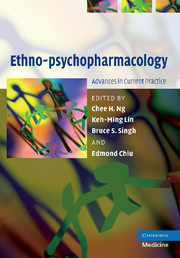Book contents
- Frontmatter
- Contents
- List of figures
- List of tables
- List of contributors
- Foreword
- Acknowledgments
- 1 Introduction
- 2 Culture and psychopathology
- 3 Culture and ethnicity in psychopharmacotherapy
- 4 Ethnic differences in psychotropic drug response and pharmacokinetics
- 5 Pharmacogenetics of ethnic populations
- 6 Variation in psychotropic responses in the Chinese population
- 7 Variation in psychotropic responses in the Hispanic population
- 8 Identifying inter-ethnic variations in psychotropic response in African Americans and other ethnic minorities
- 9 Complementary medicines in mental disorders
- 10 Cultural factors and the use of psychotropic medications
- 11 Outpatient prescribing practices in Asian countries
- 12 Psychiatric inpatient psychotropic prescribing in East Asia
- 13 Pharmaco-economic implications for Asia and other economically disadvantaged countries
- 14 Integrating theory, practice and economics in psychopharmacology
- 15 Research directions in ethno-psychopharmacology
- Index
Foreword
Published online by Cambridge University Press: 22 August 2009
- Frontmatter
- Contents
- List of figures
- List of tables
- List of contributors
- Foreword
- Acknowledgments
- 1 Introduction
- 2 Culture and psychopathology
- 3 Culture and ethnicity in psychopharmacotherapy
- 4 Ethnic differences in psychotropic drug response and pharmacokinetics
- 5 Pharmacogenetics of ethnic populations
- 6 Variation in psychotropic responses in the Chinese population
- 7 Variation in psychotropic responses in the Hispanic population
- 8 Identifying inter-ethnic variations in psychotropic response in African Americans and other ethnic minorities
- 9 Complementary medicines in mental disorders
- 10 Cultural factors and the use of psychotropic medications
- 11 Outpatient prescribing practices in Asian countries
- 12 Psychiatric inpatient psychotropic prescribing in East Asia
- 13 Pharmaco-economic implications for Asia and other economically disadvantaged countries
- 14 Integrating theory, practice and economics in psychopharmacology
- 15 Research directions in ethno-psychopharmacology
- Index
Summary
This book is very important for two reasons: it is the first-ever textbook of psychopharmacology focusing on the Asia-Pacific region, and it is, as far as I know, the first internationally authored volume dealing specifically with ethno-psychopharmacology.
Both developments are remarkable. In the past few years, the international literature has been enriched by textbooks of psychiatry focusing on Latin America, Asia and Africa, which have proved to be very useful to clinicians in the respective regions, while at the same time providing the international readership with a lot of previously unavailable information. If these textbooks have been useful, even more timely may be this first “regional” textbook of psychopharmacology, which is likely to improve psychiatric practice in the Asia-Pacific region and represent a model for other regions of the world.
On the other hand, a book on ethno-psychopharmacology, which could perhaps have been regarded as a scientific curiosity a decade ago, will certainly not be perceived as such today by the vast majority of psychiatrists worldwide. Most of us live now in multiethnic environments, in which cultural variations in the expression of psychopathology can be directly observed by the average practitioner, and in which problems in communication and diagnostic approach to persons with different ethnic and cultural backgrounds are being experienced on a daily basis. Increasingly widespread also is the awareness of the ethnic and cultural variations in the response to the most common psychotropic medications, which is certainly a matter of genetic polymorphisms, but also a consequence of the impact of a variety of environmental factors.
- Type
- Chapter
- Information
- Ethno-psychopharmacologyAdvances in Current Practice, pp. xiii - xivPublisher: Cambridge University PressPrint publication year: 2008



